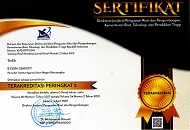MENGEMBANGKAN RESILIENSI REMAJA DALAM UPAYA MENGATASI STRES SEKOLAH
Abstract
School today are facing the difficult challenges of ensuring success for all students and fostering an empowered, enthusistic staff of lifelong. This article is about developing “resiliency”, a new paradigma of student development that offers schools a coherent. The foundation for the resiliency paradgma is a dramatic new perspective on how children and adolescence bounce back from stress, trauma, and risk in their lives that is emerging from the fields of psychiatry, psychology, and sociology. An understanding of resiliency, its importance, and the way schools can help students bounce back and evolve into more competent and successful learners is needed now more than ever. In this article, resiliency is defined and six-step plan of action for resiliency building is introduced.
Kata Kunci: resiliensi remaja, mengatasi stress sekolahFull Text:
PDF (Bahasa Indonesia)References
Arends, R.I., (1998), Learning to Teach, Singapore: McGraw-Hill.
Burns, T., & Lofquist, B. (1996). The Next Step: Integrating Resiliency and Community Development in the School, Tucson: Development Publications.
Desmita, (2005), Psikologi Perkembang-an, Bandung: Rosdakarya.
Grotberg, E.H., (1999). Taping Your Inner Strength: How to Find the Resilience to Deal with Anything, Oakland, CA.: New Harbinger Publications, Inc.
_____, (1995). A Guide to Promoting Resilience in Children: Strengt-hening the Human Spirit, Den Haag: Bernad van Leer Foundation,
_____, (1997), The international resi-lience project: Research, appli-cation, and policy, Makalah dipresentasikan pada The Sympo-sio Internacional: Stress e Violencia, Lisboa, Portugal.
Henderson, V.L., & Dwesk, C.S. (1990), Motivation and achievement, dalam: S.S. Feldman & G.R. Elliott (Eds.), At the Threshold: The Developing Adolescent, Cambridge, MA: Harvard University Press.
Higgins, G.O. (1994). Resilient Adults: Overcoming a Cruel Past, San Francisco: Jossey-Bass.
Kaufman, J., Cook, A., Arny, L., Jones, B., & Pittinsky, T. (1994). Problems defining resilience: Illustrations from the study of maltreated children, Development and Psychopathology, 6, 115-147.
Krovetz, M.L. (1999). Fostering Resiliency: Expecting all Students to Use their Minds and Hearts well, ME: KIDS Consortium.
Richardson, G.E., Neiger, B.L., Jenson, S., & Kumpfer, K.L. (1990), The resiliency model, Health Education, 21 (6), 33-39.
Rutter, M., (1984). Resilient Children, Psychology Today, March, 57-65
Wolin, S.J., & Wolin, S. (1993). The Resiliency Self: How Survivors of Troubled Families Rise Above Adversity, New York: Villard
DOI: http://dx.doi.org/10.31958/jt.v12i1.150
Refbacks
- There are currently no refbacks.
Copyright (c) 2009 DESMITA DESMITA

This work is licensed under a Creative Commons Attribution-NonCommercial-NoDerivatives 4.0 International License.
TA'DIB with registered number e-ISSN: 2580-2771, p-ISSN: 1410-8208 have been indexed on:

Journal Ta'dib distribute under Lisensi Creative Commons Atribusi-NonKomersial 4.0 Internasional.
Contact us: Ta'dib; Address: FTIK, Universitas Islam Negeri Mahmud Yunus Batusangkar; Jl. Sudirman No. 137 Lima Kaum Batusangkar, Tanah Datar, Sumatera Barat, Indonesia. Email: takdib@uinmybatusangkar.ac.id

























